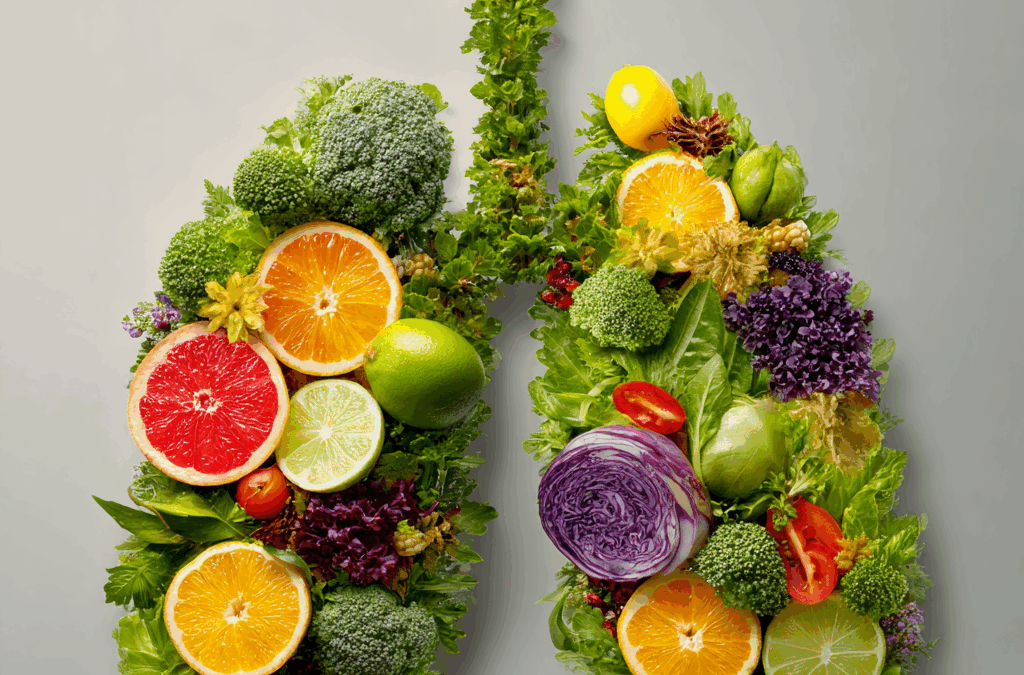
Lung-Healing Diet – Foods That Help You Breathe Better – Ch 4 – Breathe to Heal: How Nutrition and Lifestyle Can Save Your Lungs
Chapter 4: The Lung-Healing Diet — Foods That Help You Breathe Better
Breathe to Heal: How Nutrition and Lifestyle Can Save Your Lungs
“Every bite you take is a message to your body — a signal to heal or to inflame.”
Your lungs may live in your chest, but their health begins in your kitchen.
We often think of breathing as separate from eating — air goes into the lungs, food into the stomach — yet the two systems are intimately connected.
What you eat shapes your body’s internal chemistry, affecting inflammation, immunity, and even how efficiently your cells use oxygen.
A lung-healthy diet isn’t about deprivation — it’s about restoring harmony between your environment and your biology.
And the science is now clear: food can profoundly strengthen your respiratory system, repair tissue damage, and reduce your risk of chronic disease.
🧬 Food as Medicine for Your Lungs
Every meal influences the state of your respiratory system.
A high-sugar, high-fat, processed meal can cause measurable inflammation within hours. Conversely, an antioxidant-rich, nutrient-dense meal can lower inflammation markers and enhance lung performance.
In a 2024 study published in The European Respiratory Journal, participants who consumed five or more servings of fruits and vegetables daily had 35% better lung function and 25% fewer respiratory infections than those who ate less than two servings.
Food isn’t just fuel — it’s biochemical information.
Your body listens carefully to what you eat and adjusts accordingly.
🌿 1. The “Breath Plate”: The Foundation of the Lung-Healing Diet
Imagine your plate divided into four sections, each playing a vital role in nourishing your lungs:
| Plate Section | Food Type | Function |
|---|---|---|
| 🥬 Anti-Inflammatory Plants | Leafy greens, cruciferous vegetables, berries, herbs | Quench inflammation, provide antioxidants |
| 🐟 Healthy Fats & Proteins | Wild salmon, sardines, flaxseed, walnuts, legumes | Rebuild tissue, support cell membranes |
| 🍊 Vitamin-Rich Fruits | Citrus, kiwi, papaya, apples | Boost lung elasticity, reduce oxidative stress |
| 🌾 Whole Grains & Fiber | Oats, quinoa, brown rice, lentils | Feed gut microbiome, balance blood sugar |
This simple visual helps you make each meal a lung-supportive one — full of color, balance, and vitality.
🍊 2. The Nutrients That Power Every Breath
Let’s explore the key nutrients your lungs depend on — and where to find them.
Vitamin C — The Oxygen Shield
Why it matters:
Vitamin C protects lung tissue from free radicals caused by pollution and smoke. It also supports collagen formation, keeping airways flexible.
Best sources:
Citrus fruits, bell peppers, kiwi, guava, strawberries, broccoli.
Science:
A British Medical Journal meta-analysis found that high Vitamin C intake lowered the risk of chronic bronchitis by 30%.
Vitamin D — The Immune Regulator
Why it matters:
Vitamin D reduces inflammation, supports immune balance, and may protect against asthma and viral infections.
Best sources:
Sunlight, salmon, egg yolks, mushrooms, fortified plant milks.
Science:
People with optimal Vitamin D levels show 50% fewer respiratory infections in winter months (JAMA Internal Medicine, 2022).
Magnesium — The Bronchodilator Mineral
Why it matters:
Magnesium relaxes smooth muscles in the bronchial tubes, easing airflow and preventing spasms.
Best sources:
Spinach, almonds, avocado, pumpkin seeds, dark chocolate.
Science:
Low magnesium levels are linked to reduced lung capacity and higher asthma rates (European Journal of Clinical Nutrition, 2023).
Omega-3 Fatty Acids — The Inflammation Coolant
Why it matters:
Omega-3s from fish and plants reduce inflammatory cytokines and improve oxygen exchange.
Best sources:
Salmon, mackerel, flaxseeds, chia seeds, walnuts.
Science:
In COPD patients, omega-3 supplementation improved breathing endurance by 25% and lowered inflammation markers (American Journal of Clinical Nutrition, 2024).
Flavonoids — The Lung’s Natural Antioxidants
Why it matters:
These plant compounds scavenge free radicals and support lung detoxification.
Best sources:
Berries, apples, onions, tea, parsley, red grapes.
Science:
A Harvard cohort study found that high flavonoid intake was linked to better lung elasticity and slower aging of respiratory tissue.
🌾 3. Fiber and the Gut-Lung Axis
One of the most fascinating discoveries of the last decade is the gut-lung axis — the communication pathway between your digestive system and your respiratory system.
Healthy gut bacteria produce short-chain fatty acids (SCFAs), which lower inflammation throughout the body, including the lungs.
A diet high in fiber (fruits, vegetables, legumes, whole grains) feeds these beneficial microbes and strengthens immune defenses in the airways.
In contrast, a low-fiber, high-sugar diet promotes “leaky gut” and systemic inflammation that reaches the lungs.
Remember: A healthy gut = resilient lungs.
🍵 4. Detoxifying Foods That Cleanse the Airways
You don’t need fancy “detox teas.” The real detoxifiers are already in your produce aisle.
-
Garlic & Onions – Contain allicin, which has antimicrobial and anti-inflammatory effects.
-
Turmeric – Rich in curcumin, which downregulates inflammatory cytokines.
-
Ginger – Improves circulation, reduces mucus buildup, and relaxes airway muscles.
-
Green Tea – Packed with catechins that protect lung tissue from oxidative stress.
-
Cruciferous Veggies (broccoli, kale, cauliflower) – Stimulate detox enzymes in the liver, easing the burden on the lungs.
These foods work together to help your body process and eliminate toxins — lightening the load on your respiratory system.
🥑 5. The Foods That Harm the Lungs
To truly heal, it’s not enough to add good foods — you must also avoid the ones that silently damage your lungs.
The “Dirty Air Diet” includes:
-
Fried and processed foods → promote oxidative stress.
-
Refined carbohydrates → spike blood sugar and increase inflammation.
-
Processed meats → contain nitrites linked to COPD.
-
Sugary drinks → raise insulin and impair immune response.
-
Excess dairy (for some) → increases mucus and congestion.
Tip: Instead of eliminating everything overnight, replace one harmful habit per week.
For example: swap soda for green tea, or processed meats for grilled salmon.
🧩 6. Hydration: The Forgotten Breath Enhancer
The lungs are nearly 80% water.
Dehydration thickens mucus, making it harder to clear airways and increasing the risk of infection.
Aim for 2–3 liters of water daily, plus hydrating foods like cucumbers, citrus, melons, and soups.
Add a pinch of Himalayan salt or electrolytes if you’re sweating or in dry climates — this helps maintain airway moisture.
Even mild dehydration can reduce oxygen transfer efficiency by 5–10% — that’s like aging your lungs several years in a day.
🥣 7. The 24-Hour “Breathe Better” Meal Plan
Here’s how a day of lung-healing eating might look:
🌅 Breakfast:
-
Warm lemon water with ginger
-
Oatmeal topped with blueberries, flaxseed, and almonds
-
Green tea
🍱 Lunch:
-
Lentil and kale soup with olive oil
-
Grilled salmon or tofu
-
Fresh citrus salad
☕ Snack:
-
Apple slices with almond butter
-
Herbal tea with turmeric and honey
🌇 Dinner:
-
Quinoa and vegetable stir-fry with broccoli, garlic, and mushrooms
-
Side of roasted sweet potatoes
-
Peppermint or chamomile tea before bed
💧 Throughout the day:
Hydrate regularly. Practice slow, deep breathing before each meal to engage your parasympathetic system and improve digestion.
🌤️ 8. Food Is Only the Beginning
Nutrition lays the foundation for healing, but it works best when paired with clean air, movement, and mindful breathing.
Together, they form a feedback loop of vitality:
Eat well → breathe better → reduce inflammation → crave healthier foods.
Your body is not your enemy — it’s your ally.
When you feed it what it was designed to thrive on, it will heal faster than you can imagine.
Every bite becomes a breath of renewal.
🔑 Key Takeaway
Your lungs respond directly to what you eat. An anti-inflammatory, antioxidant-rich diet — paired with hydration and mindful breathing — can reverse years of damage and restore your natural vitality.



